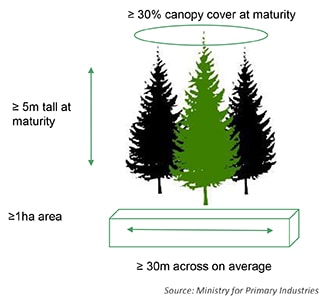Eligibility
There are several elements that need to work together in order to benefit from carbon farming:
- land eligibility,
- type of forest, and
- land ownership.
If you are clear about all these elements check out our mapping tool. For more information about funding options, see the Funding page.
Land eligibility
To be eligible for carbon farming payments, the land must be currently forest land and MUST fall within one of these categories:
- It wasn’t forest land on 31 December 1989 OR
- It was forest land on 31 December 1989, but was deforested after then but before 1 January 2008 OR
- It was forest land pre-1990, but was deforested on or after 1 January 2008, and the ETS liability has been paid.
Type of forest
The forest must meet ALL of the following:
- Have at least 1 ha of forest species AND
- Have or is likely to have an average width of tree crown cover of at least 30 metres AND
- Have trees capable of reaching at least 5m in height AND
- have or is likely to have over 30% crown cover per hectare.

The forest land can’t be:
- Grassland,
- Narrow shelterbelts,
- Trees grown primarily for fruit or nut crops,
- Gorse or broom (unless acting as a nurse crop where there is sufficient forest species stock also present that meets the above criteria),
- Scattered forest species unlikely to ever meet 30% crown cover under existing management,
- Wilding forest (unless the risk of spread is low).
Land ownership
Below is a tool that allows you to work through whether you have the right kind of land ownership to become a carbon farmer.
- Are you the landowner? You will need to prove this with a Certificate of Title or a Maori Land Court reference
Mapping tool
Motu has created a mapping tool that Māori landowners in Tairāwhiti can use to assess the eligibility of their land for carbon farming (through the Emissions Trading Scheme) and the Erosion Control Funding Programme. The map lets a landowner find their land, and then click on it to see:
- how much of their block is likely to qualify for both the Emissions Trading Scheme and Erosion Control Funding Programme funding,
- how much is likely to qualify only for Emissions Trading Scheme funding, and
- how much of their land does not qualify for funding.
If the map tool doesn’t work on your computer, you can download a less interactive version, and search for your block on this downloadable spreadsheet to see how much of your land is likely to be eligible for the Emissions Trading Scheme and Erosion Control Funding Programme.
For more information about these funding options, see the Funding page.
“We were sitting on our hands, right? With money invested from the sale of stock and other assets in financial portfolios. So each year we were reliant on what the share-market was doing, and what bonds were doing, in order to get income to operate the Trust, and still trying to grow that portfolio. So then to get a carbon cheque each year of – after tax – around $150,000, it is quite a significant amount for doing nothing different.”
Māori landowner
“When I think about the deals we have done, they have largely been because we care about the relationship [with landowners], but it is more complex…. I think you do need to have people… that want a relationship.”
large scale emitter